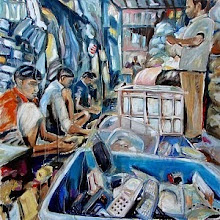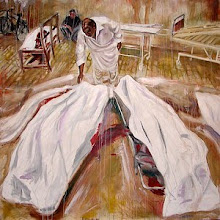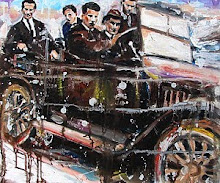It has been shown that cultural artefacts found in southeastern Europe date from 6500 to 3500 B.C.E. and in western Europe from 4500 to 2500 B.C.E. and that ancient beliefs, myths and rituals recorded in historical times are essential to the understanding of prehistoric symbols.
The aim of this collection of notes, quotes, and illustrations is to refigure lost narratives and reinterpret our cultural memory as a way to creating a progressive culture today. One way of doing this is to extend the examined cultural history back much further than the foundational myths of Prometheus and Adam.
The purpose of extending this inquiry to earlier belief systems is to show that the changes which took place then give us a different perspective on the usual interpretations of even the foundational myths.
The implications of these changes have radical implications for culture through time and its philosophical and ideological bases today.
Prehistoric art
The earliest known European art is from the Upper Palaeolithic period and includes both cave painting, such as the famous paintings at Chauvet, Altamira, Pech Merle, and Lascaux, and portable art, such as animal carvings and so-called Venus figurines like the Venus of Willendorf.
http://en.wikipedia.org/wiki/Prehistoric_art
Fertility goddess
The fertility goddesses are the female deities to watch over and promote fertility, pregnancy, and birth in many polytheistic cultures. In some cases these deities were directly associated with sex, and in others they simply embodied related attributes. Some examples include Aphrodite in ancient Greece, Hathor in ancient Egypt, the Teutonic goddess Freyja, and Brigit in Ireland. Fertility gods are also present in many other cultures. Some archeological finds that have become associated with ancient fertility goddesses in the popular imagination are Venus figurines such as the Venus of Willendorf.
http://en.wikipedia.org/wiki/Fertility_goddess

Venus of Willendorf - estimated to have been carved
between 24,000 - 22,000 BCE (wikipedia.org)
Matrilocality
Matrilocality (also known as Uxorilocal marriage) is a term used in social anthropology. It describes a societal system in which the offspring of a mother remain living in the mother's house, thereby forming large "clan-families", typically consisting of three or four generations living under the same roof. Frequently, visiting marriage is being practiced, meaning that husband and wife are living apart in their separate families, seeing each other in their spare time. The children of such marriages are raised by the mother's extended matrilineal clan. The father does not have a significant role in the upbringing of his own children; he does, however, in that of his sisters' children. In direct consequence, property is inherited from generation to generation, and over all, remains largely undivided.
http://en.wikipedia.org/wiki/Matrilocality
Mother right
According to mother right - so long, therefore, as descent was reckoned only in the female line - and according to the original custom of inheritance within the gens, the gentile relatives inherited from a deceased fellow member of their gens. The property had to remain within the gens*. […] Thus, in proportion as wealth increased, it on the one hand made the man’s position in the family more important than the woman’s, and on the other hand created an impulse to use this strengthened position in order to overthrow, in favour of his children, the traditional order of inheritance. […] A simple decision sufficed that in the future the offspring of the male members should remain within the gens, but that of the female should be excluded by being transferred to the gens of their father. The reckoning of descent in the female line and the law of maternal inheritance where thereby overthrown, and the male line of descent and the law of paternal inheritance were substituted for them. As to how and when this revolution took place among civilized peoples, we have no knowledge. It falls entirely within prehistoric times.
Frederick Engels The Origin of the Family, Private Property and the State
* In ancient Rome, a gens (pl. gentes) was a clan, caste, or group of families, that shared a common name (the nomen) and a belief in a common ancestor. In the Roman naming convention, the second name was the name of the gens to which the person belonged. The term has also been used to refer to families within a clan system in other contexts, including tribal clans.
The aim of this collection of notes, quotes, and illustrations is to refigure lost narratives and reinterpret our cultural memory as a way to creating a progressive culture today. One way of doing this is to extend the examined cultural history back much further than the foundational myths of Prometheus and Adam.
The purpose of extending this inquiry to earlier belief systems is to show that the changes which took place then give us a different perspective on the usual interpretations of even the foundational myths.
The implications of these changes have radical implications for culture through time and its philosophical and ideological bases today.
Prehistoric art
The earliest known European art is from the Upper Palaeolithic period and includes both cave painting, such as the famous paintings at Chauvet, Altamira, Pech Merle, and Lascaux, and portable art, such as animal carvings and so-called Venus figurines like the Venus of Willendorf.
http://en.wikipedia.org/wiki/Prehistoric_art
Fertility goddess
The fertility goddesses are the female deities to watch over and promote fertility, pregnancy, and birth in many polytheistic cultures. In some cases these deities were directly associated with sex, and in others they simply embodied related attributes. Some examples include Aphrodite in ancient Greece, Hathor in ancient Egypt, the Teutonic goddess Freyja, and Brigit in Ireland. Fertility gods are also present in many other cultures. Some archeological finds that have become associated with ancient fertility goddesses in the popular imagination are Venus figurines such as the Venus of Willendorf.
http://en.wikipedia.org/wiki/Fertility_goddess

Venus of Willendorf - estimated to have been carved
between 24,000 - 22,000 BCE (wikipedia.org)
Matrilocality
Matrilocality (also known as Uxorilocal marriage) is a term used in social anthropology. It describes a societal system in which the offspring of a mother remain living in the mother's house, thereby forming large "clan-families", typically consisting of three or four generations living under the same roof. Frequently, visiting marriage is being practiced, meaning that husband and wife are living apart in their separate families, seeing each other in their spare time. The children of such marriages are raised by the mother's extended matrilineal clan. The father does not have a significant role in the upbringing of his own children; he does, however, in that of his sisters' children. In direct consequence, property is inherited from generation to generation, and over all, remains largely undivided.
http://en.wikipedia.org/wiki/Matrilocality
Mother right
According to mother right - so long, therefore, as descent was reckoned only in the female line - and according to the original custom of inheritance within the gens, the gentile relatives inherited from a deceased fellow member of their gens. The property had to remain within the gens*. […] Thus, in proportion as wealth increased, it on the one hand made the man’s position in the family more important than the woman’s, and on the other hand created an impulse to use this strengthened position in order to overthrow, in favour of his children, the traditional order of inheritance. […] A simple decision sufficed that in the future the offspring of the male members should remain within the gens, but that of the female should be excluded by being transferred to the gens of their father. The reckoning of descent in the female line and the law of maternal inheritance where thereby overthrown, and the male line of descent and the law of paternal inheritance were substituted for them. As to how and when this revolution took place among civilized peoples, we have no knowledge. It falls entirely within prehistoric times.
Frederick Engels The Origin of the Family, Private Property and the State
* In ancient Rome, a gens (pl. gentes) was a clan, caste, or group of families, that shared a common name (the nomen) and a belief in a common ancestor. In the Roman naming convention, the second name was the name of the gens to which the person belonged. The term has also been used to refer to families within a clan system in other contexts, including tribal clans.
(http://en.wikipedia.org/wiki/Gens)
Mythology and ideology
Dumezil (1898-1986) devoted his life work to establishing mythology as an independent branch of the social sciences. His studies have shown that mythic beings are the means for explaining the order of mankind and the origins of the universe, and that mythic thinking is not accidental but occurs within an organized system of divine activities and functions. Thus mythology reflects an ideological structure.
Marija Gimbutas The Language of the Goddess (p xviii)
Hera
Hera was the Mother of the Gods, even of the Olympian gods, to whom she gave the ambrosia of eternal life. Hellenic writers tried to make her subordinate to Zeus, though she was much older than he, and had married him against her will. Their constant mythological quarrels reflected conflicts between early patriarchal and matriarchal cults. As the primordial feminine trinity, Hera appeared as Hebe, Hera, and Hecate - new moon, full moon, old moon - otherwise personified as the Virgin of spring, the Mother of summer, and the destroying Crone of winter.
Barbara Walker The Women's Encyclopedia of Myths and Secrets (p392)
The magic apple garden
Greeks said Mother Hera kept the magic apple garden in the west, where the Tree of Life was guarded by her sacred serpent. Graves points out that the whole story of Eve, Adam, and the serpent in the tree was deliberately misinterpreted from icons showing the Great Goddess offering life to her worshipper, in the form of an apple [the symbol of immortality], with the tree and its serpent in the background.
Barbara Walker The Women's Encyclopedia of Myths and Secrets (p49)

Adam und Eva von Lucas Cranach um 1513/15
Öl auf Holz 73 x 62 in Würzburg,
Mainfränkisches Museum (wikipedia.org)
The Serpent as Goddess
The symbol of the Serpent was the one most widely used to represent or adorn the Goddess of the ancient Near East or to depict, or mediate, the relationship between goddesses and human culture. [...] In its association with life, the Serpent represented much more than mere sexual fertility, although fertility was an important theme of the cultic occasions when serpentine imagery was used. Serpents hibernate in the winter and re-emerge in the spring. For this reason they were ideal symbols of the rebirth of nature every year and and represented a guarantee that even though all of life might seem to die off in the winter months, there was yet hope for the earth.
Mary Condren The Serpent and the Goddess (p8)
Promise and History
Allegiance would have to be to one god, Yahweh, and the central symbolism of the new religion would be based on Promise and History rather than on the Life and Cyclical Regeneration represented by the Serpent.
Mary Condren The Serpent and the Goddess (p11)
Mythology and ideology
Dumezil (1898-1986) devoted his life work to establishing mythology as an independent branch of the social sciences. His studies have shown that mythic beings are the means for explaining the order of mankind and the origins of the universe, and that mythic thinking is not accidental but occurs within an organized system of divine activities and functions. Thus mythology reflects an ideological structure.
Marija Gimbutas The Language of the Goddess (p xviii)
Hera
Hera was the Mother of the Gods, even of the Olympian gods, to whom she gave the ambrosia of eternal life. Hellenic writers tried to make her subordinate to Zeus, though she was much older than he, and had married him against her will. Their constant mythological quarrels reflected conflicts between early patriarchal and matriarchal cults. As the primordial feminine trinity, Hera appeared as Hebe, Hera, and Hecate - new moon, full moon, old moon - otherwise personified as the Virgin of spring, the Mother of summer, and the destroying Crone of winter.
Barbara Walker The Women's Encyclopedia of Myths and Secrets (p392)
The magic apple garden
Greeks said Mother Hera kept the magic apple garden in the west, where the Tree of Life was guarded by her sacred serpent. Graves points out that the whole story of Eve, Adam, and the serpent in the tree was deliberately misinterpreted from icons showing the Great Goddess offering life to her worshipper, in the form of an apple [the symbol of immortality], with the tree and its serpent in the background.
Barbara Walker The Women's Encyclopedia of Myths and Secrets (p49)

Öl auf Holz 73 x 62 in Würzburg,
Mainfränkisches Museum (wikipedia.org)
The Serpent as Goddess
The symbol of the Serpent was the one most widely used to represent or adorn the Goddess of the ancient Near East or to depict, or mediate, the relationship between goddesses and human culture. [...] In its association with life, the Serpent represented much more than mere sexual fertility, although fertility was an important theme of the cultic occasions when serpentine imagery was used. Serpents hibernate in the winter and re-emerge in the spring. For this reason they were ideal symbols of the rebirth of nature every year and and represented a guarantee that even though all of life might seem to die off in the winter months, there was yet hope for the earth.
Mary Condren The Serpent and the Goddess (p8)
Promise and History
Allegiance would have to be to one god, Yahweh, and the central symbolism of the new religion would be based on Promise and History rather than on the Life and Cyclical Regeneration represented by the Serpent.
Mary Condren The Serpent and the Goddess (p11)















No comments:
Post a Comment